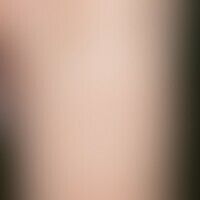Image diagnoses for "Scalp (hairy)"
120 results with 343 images
Results forScalp (hairy)

Scrotal and vulval angiosclerosis D23.9
Angiokeratoma of the glans penis. multiple, chronically stationary, 0.2-0.4 cm large, blue-red to brownish papules with partly smooth, partly scaly surface in the area of the corona glandis. these are congenital, circumscribed vascular ectasias.

Aplasia cutis congenita (overview) Q84.81

Aplasia cutis congenita (overview) Q84.81

Aplasia cutis congenita (overview) Q84.81

Giant cell arteritis M31.6
arteriitis temporalis. suddenly appeared, bizarrely configured, only moderately painful, large ulcerations covered with black crusts. prominent and on palpation strand-like indurated A. temporalis (right side). neither right nor left side positive flow signal over the temporal arteries.

Atheroma L72.10

Atheroma L72.10

Atheroma L72.10

Atrichia congenita with horny cysts Q84.0

Exclamation mark hairs L67.9
Alopecia areata : cadaveric (comedone-like aspect) and exclamation mark hairs (see below right).

Tuft hair L66.2
Tufted hairs:Folliculitis decalvans: Scar plate with wicklike tufts of hair in the centre, also in the marginal area of the scarring (see also under Folliculitis decalvans).

Cheilitis granulomatosa G51.2

Cornu cutaneum L85
Cornu cutaneum: multiple plaques and nodules with exophytic growth and hyperkeratotic surface, localized on the actinic massive pre-damaged capillitium of an elderly patient.

Culicosis T14.0

Cutis verticis gyrata L91.8
Cutis verticis gyrata: cerebriform (gyriform), symmetrical, asymptomatic folds and furrows of the scalp.

Cutis verticis gyrata L91.8
Cutis verticis gyrata: Lateral profile of the capillitium of a 26-year-old patient (bodybuilder), who after extensive use of anabolic steroids developed these cerebriform thickenings, furrows and folds of the capillitium, which had been progressive for 6 months.

Cutis verticis gyrata L91.8

Cutis verticis gyrata L91.8
Cutis verticis gyrata: cerebriform thickenings, furrows and folds of the capillitium which have existed for years but are increasing; cause unknown; no familial occurrence.

Dyskeratosis follicularis Q82.8
Dyskeratosis follicularis: Infestation of the palms of the hands; in central areas of the palm flat, common keratoses, at the ball of the thumb about 0.1-0.2 cm large, glassy papules.

Dyskeratosis follicularis Q82.8
Dyskeratosis follicularis: 74-year-old woman. large , hyperkeratotic zones with reddish, partly macerated papules and firmly adhering, partly eroded, confluent keratoses on the capillitium and in the facial area preauricularly, existing since early childhood. the patient has a somewhat neglected appearance. the skin lesions have a foetal odour. the lesions increase with sweating or heat, especially in the warm season.

Favus B35.0
Favus. solitary, acute, approx. 3.0 x 2.5 cm, acutely acute, approx. 3.0 x 2.5 cm in size, localized on the capillitium, sharply defined, plumply raised, clearly increased in consistency, white, rough, with yellow crusts, asymptomatic plaque in a 7-year-old boy. A slight mouse urine smell was noticed during the examination.

Folliculitis decalvans L66.2
folliculitis decalvans. low inflammatory, "burnt out" disease state. appearance of scarred alopecia with discrete, heart-shaped reddening around the marginal hair follicles. the present condition approaches the finding of "pseudopelade brocq".

Folliculitis decalvans L66.2
Folliculitis decalvans: extensive scarring inflammation with destruction of the hair follicles, typical tuft hair formation.

Folliculitis decalvans L66.2
Folliculitis decalvans. One year later, progressive scarring, obvious follicular inflammation.

Folliculitis decalvans L66.2
Folliculitis decalvans. 12 months of persistent scarring hair loss, with initially slight itching in a 66-year-old female patient. In addition to purulent folliculitis, tufted hairs with surrounding erythema and numerous small, shiny, hairless areas appear.